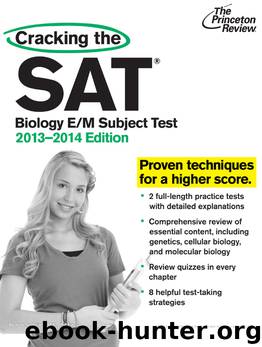Cracking the Sat Biology E/M Subject Test, 2013-2014 Edition by The Princeton Review

Author:The Princeton Review [Review, The Princeton]
Language: eng
Format: epub
Tags: Itzy, Kickass.to
ISBN: 9780307945723
Amazon: B00C4BA5OY
Publisher: Princeton Review
Published: 2013-04-16T04:00:00+00:00
7. Blood type AB can donate blood to blood type [ AB A B O all of them ].
8. Alleles IA and IB are said to be ______________________________.
Correct answers can be found in Chapter 15.
The Blood Vessels
At the center of the circulatory system is the heart, which acts as a pump. The blood vessels lead away from the heart and enter the tissues, then return to the heart. The heart pumps blood through the blood vessels.
This diagram represents a very basic circuit. Any vessel that carries blood away from the heart is called an artery. Arteries carry blood Away from the heart. The blood pressure inside arteries is relatively high, and they have thick, muscular walls that regulate their diameters to regulate blood flow. Blood moves through arteries mostly through momentum, because of the big “push” it gets from the heart. As they travel away from the heart, arteries get smaller and smaller and branch out (not shown above) into arterioles and, ultimately, capillaries.
Capillaries are the smallest blood vessels in the body and are the site of exchange between blood and tissues. Oxygen and nutrients (such as glucose) leave the blood and enter the tissues, and carbon dioxide and other waste products leave the tissues and are picked up by the blood. Blood flow is slow enough here so that there is enough time for this exchange. And, again, even though it’s not shown above, arterioles branch into thousands and thousands of capillaries. For this reason, blood pressure drops substantially in the capillaries.
Capillaries then merge to form larger vessels, called venules, which merge to form even larger vessels called veins, which carry blood back to the heart. Any vessel that returns blood to the heart is called a vein. Blood loses most of its forward momentum and pressure as it crosses through the capillaries, so the pressure in the veins is relatively low. As your body moves around and skeletal muscles contract, veins get squeezed, and this pushes the blood along toward the heart. It’s just like when you pick up a garden hose and squeeze it and water runs out. But because we want blood to run in only one direction in the veins (water in a hose would run out in both directions) the veins have valves, which ensure that the blood keeps moving in the direction we want it to—toward the heart. Veins do not have muscular walls. They do not regulate blood flow. They are passive receivers, taking whatever they get from the capillaries and moving it along to the heart.
Download
This site does not store any files on its server. We only index and link to content provided by other sites. Please contact the content providers to delete copyright contents if any and email us, we'll remove relevant links or contents immediately.
| Cell Biology | Developmental Biology |
| Entomology | Marine Biology |
| Microbiology | Molecular Biology |
| Biostatistics |
Sapiens: A Brief History of Humankind by Yuval Noah Harari(14250)
The Tidewater Tales by John Barth(12608)
Mastermind: How to Think Like Sherlock Holmes by Maria Konnikova(7227)
Do No Harm Stories of Life, Death and Brain Surgery by Henry Marsh(6888)
The Thirst by Nesbo Jo(6826)
Why We Sleep: Unlocking the Power of Sleep and Dreams by Matthew Walker(6618)
Life 3.0: Being Human in the Age of Artificial Intelligence by Tegmark Max(5474)
Sapiens by Yuval Noah Harari(5293)
The Longevity Diet by Valter Longo(5018)
The Body: A Guide for Occupants by Bill Bryson(4974)
The Rules Do Not Apply by Ariel Levy(4858)
The Immortal Life of Henrietta Lacks by Rebecca Skloot(4525)
Animal Frequency by Melissa Alvarez(4394)
Why We Sleep by Matthew Walker(4359)
The Hacking of the American Mind by Robert H. Lustig(4318)
Yoga Anatomy by Kaminoff Leslie(4304)
All Creatures Great and Small by James Herriot(4232)
Double Down (Diary of a Wimpy Kid Book 11) by Jeff Kinney(4206)
Barron's AP Biology by Goldberg M.S. Deborah T(4096)
